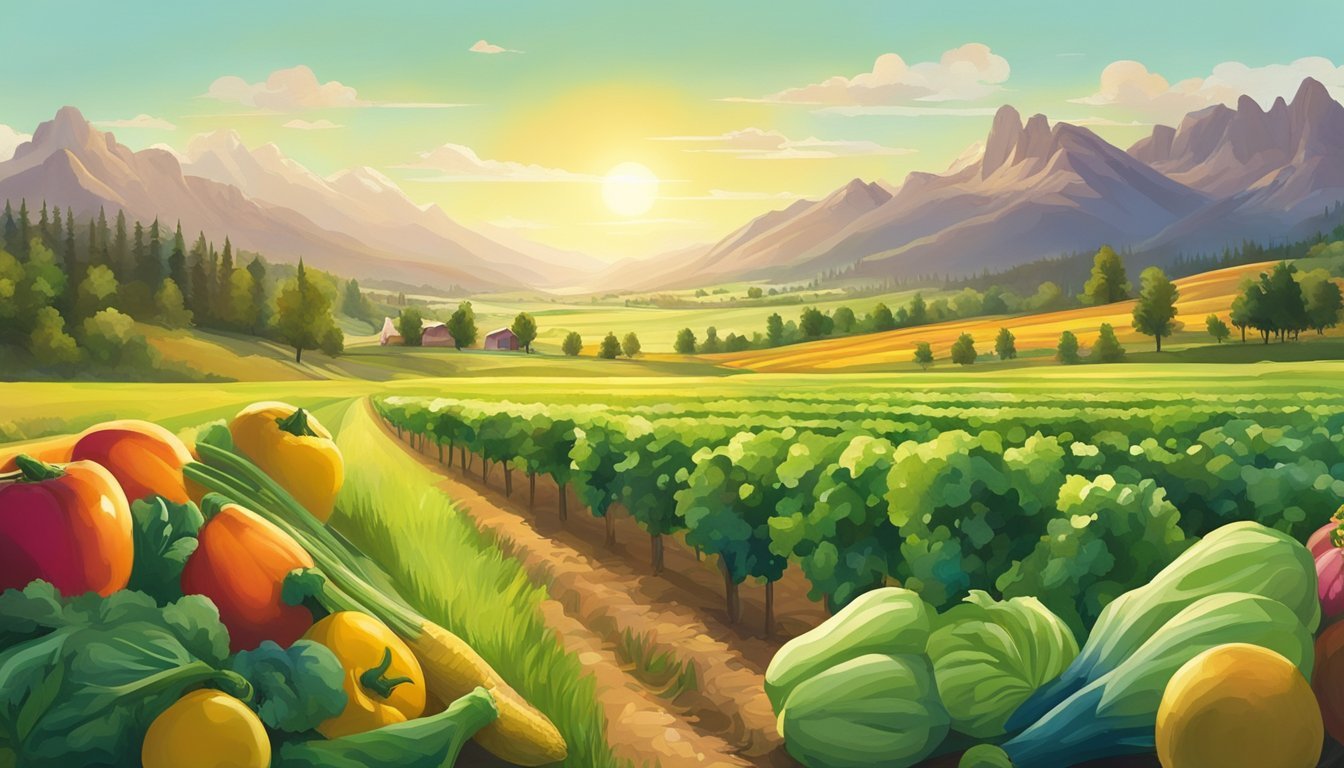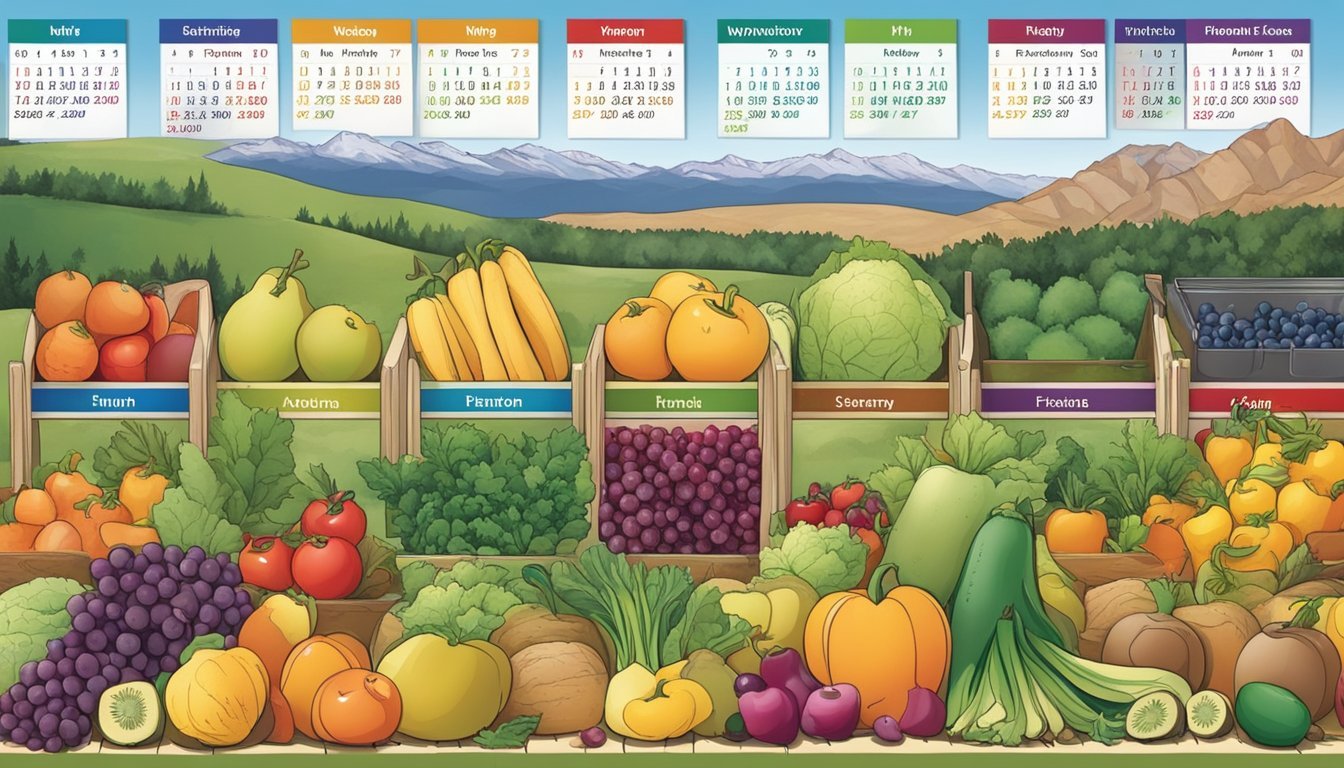Wyoming Seasonal Fruit & Veg Guide
Your Comprehensive Resource
Wyoming's diverse climate presents unique opportunities for local growers and food enthusiasts alike. The state's agricultural landscape offers a seasonal palette of fruits and vegetables that can enhance any farm-to-table experience. From the robust apple orchards that flourish in the cooler fall months to the varied selection of produce that growers nurse through the shorter growing seasons, understanding the local seasonal availability is crucial for anyone looking to tap into the freshest and most flavorful ingredients.
Local extension services, including the University of Wyoming Extension, have compiled resources like the Wyoming Vegetable and Fruit Growing Guide to aid residents and businesses in selecting the right produce at the right time. These guides are invaluable for planning menus, gardening, and supporting local agriculture. They not only promote healthful living through better nutrition but also bolster local economies by encouraging the consumption of locally grown fare.
Wyoming's focus on farm-to-table practices emphasizes not just the health benefits of eating fresh, seasonal produce, but also the cultural and economic impacts of supporting local farmers and producers. Initiatives to make such resources widely available underline the state’s commitment to sustainable practices and community well-being. It's a statewide effort to connect the dots between the soil, the harvest, and the dinner table, ensuring that Wyoming residents have access to produce that's as rich in nutrients as it is in local character.
What’s in Season in Wyoming Right Now?
Understanding Wyoming's Unique Climate and Seasons
Wyoming's climate and plant hardiness zones are pivotal for farmers and gardeners in the state. They determine the growing seasons and types of produce that can be cultivated throughout the year.
Plant Hardiness Zone and Climate
Wyoming mainly falls within the USDA Plant Hardiness Zones ranging from 3a to 5b. This means the state experiences cold winters, with minimum temperatures dropping to -40°F in zone 3a and to -15°F in zone 5b. The state's climate can be characterized as semi-arid with local variations mostly due to elevation changes, which also affect the growing seasons for various fruits (What wine goes well with fruit?) and vegetables.
Seasonal Changes and Weather Patterns
Spring in Wyoming is characterized by frequent rains and a rapid snowmelt process, with average temperatures in April ranging between 50-60°F, while May experiences a warmer 55-70°F. The state's summer is short, accompanied by warm temperatures suitable for the growth of summer crops. Autumn ushers in cooler temperatures and is a critical time for harvesting before the first frost. Winter is typically cold and long, compelling the farmers to focus on cold-hardy crops or move their operations indoors. These seasonal weather patterns guide the farmers in planning their planting and harvesting schedules, enabling a sustainable farm-to-table cycle throughout the year.
Spring in Wyoming: Preparation and Early Planting
As Wyoming's snow begins to thaw, spring emerges as a crucial time for garden enthusiasts to prepare their spaces and start planting hardy varieties of fruits and vegetables.
Prepping Your Garden Space
Before sowing any seeds, it is essential to properly prepare the garden. This involves clearing any debris from the winter months, enriching the soil with compost, and ensuring good drainage. Gardeners should test the soil's pH levels and amend it as necessary to meet the needs of their chosen crops. In Wyoming's variable spring climate, one might also consider raised beds to warm the soil more quickly.
Essential Garden Prep Steps:
Clear debris: Remove any leftover plant material and winter weeds.
Soil enrichment: Add compost or well-rotted manure to nourish the soil.
Drainage: Check for proper drainage and consider raised beds to prevent waterlogging.
pH testing: Test the soil's pH and amend accordingly.
Frost protection: Be prepared with covers to protect early plantings from late frosts.
Spring-Hardy Fruits and Vegetables
The key to success in Wyoming’s short growing season is choosing fruits and vegetables that can withstand the chilly nights of early spring. Root vegetables like kale, beets (how long do beets last?), and radishes can be planted directly into the ground as soon as it is workable, often as early as March. Due to their tolerance for cooler weather, these vegetables will start the growing season strong.
Early Spring Planting Guide:
Root Vegetables: Beets, Radishes, Carrots
Leafy Greens: Kale, Lettuce, Spinach
Cruciferous Vegetables: Broccolini, Cauliflower, Cabbage
Gardeners can also plant fruit-bearing bushes in the spring, such as hardy varieties of raspberries and strawberries that can endure Wyoming's cool spring temperatures. Herbs like parsley, cilantro, and chives (how long do chives last?) are also well-suited for an early start in the garden, thanks to their frost resistance.
Starting a garden in spring in Wyoming involves selecting the right crops for an early harvest and preparing the garden space to accommodate Wyoming's unique climate challenges. By focusing on frost-resistant fruits and vegetables, gardeners can maximize their yield from the very start of the season.
Summer Harvest: Peak Season for Freshness
In Wyoming, summer marks a time when a variety of fruits and vegetables reach their peak freshness. The warmer months bring about the optimal conditions for a bountiful harvest, providing an assortment of fresh produce to local markets and tables.
Key Fruit and Vegetable Harvests
During the summer months, the key crops in Wyoming include a range of fruits and vegetables, with tomatoes and peppers standing out due to their popularity and versatility. Below is a list of some fresh produce typically harvested in the summer:
Fruits:
Berries (strawberries, raspberries, blueberries)
Cherries(how long do cherries last?)
Apples (early varieties)
Vegetables:
Tomatoes
Peppers (bell and chili varieties)
Summer squash
Cucumbers
Green beans
Leafy greens (lettuce, spinach, kale)
These crops are crucial to the farm-to-table movement, supporting both local agriculture and community health with nutrient-rich options.
Pest and Disease Management
Managing pests and diseases is vital to ensure the quality and yield of the summer harvest. Farmers utilize various strategies to protect their crops:
Monitoring: Regular scouting for signs of pests or disease is the first line of defense.
Cultural Practices: Crop rotation, selecting disease-resistant varieties, and maintaining proper spacing can prevent outbreaks.
Natural Predators: Encouraging beneficial insects that feed on pests helps to maintain a natural balance.
Minimal Pesticide Use: When necessary, the use of pesticides is carefully managed to be effective against pests while minimizing environmental impact.
Through these integrated pest management (IPM) techniques, farmers aim to produce the freshest and most flavorful fruits and vegetables while also being stewards of the land.
Preparing for Fall: Transition Crops and Late Planting
As temperatures drop in Wyoming, gardeners should shift their focus to crops that thrive in cooler weather and consider strategies to extend the growing season for a fruitful harvest.
Extending the Growing Season
Wyoming's fall can bring early frosts, making it important for gardeners to deploy protective measures to extend the growing period. These measures include:
Utilizing cold frames or row covers to shield crops from frost.
Selecting vegetables that can endure cooler temperatures such as kale and carrots.
Implementing mulching techniques to insulate the soil, retaining heat.
Fall Favorites
Wyoming's fall harvest offers a variety of vegetables and fruits that gardeners look forward to:
Winter Squash: Planting squash, like butternut and acorn, in late spring ensures they mature and sweeten by fall.
Pumpkins: For a successful Halloween harvest, one should plant pumpkins by late June.
Apples: While apples are generally harvested in late summer, some late-ripening varieties can be picked well into the fall.
By carefully selecting crops and employing season-extension strategies, Wyoming gardeners can enjoy an abundant fall harvest.
Winter Strategies: Planning and Preservation
During Wyoming's winter months, the focus shifts from active growing to preserving the bounty of the past season and planning for the upcoming year. Effective storage strategies and a well-considered plan ensure that seasonal produce is maximized for year-round use.
Storing and Preserving Produce
Proper storage and preservation are essential for extending the availability of fruits and vegetables beyond their harvest season. In Wyoming, root cellars or insulated storage spaces can be utilized to store hardy produce like potatoes, carrots, and apples at appropriate humidity and temperatures, ensuring their longevity.
Dried fruits and vegetables are another winter staple, with the drying process concentrating flavors and natural sugars, making them perfect for snacking or cooking. Preservation methods such as canning or freezing also play a vital role, allowing one to enjoy summer's tomatoes or autumn's berries during the cold months.
Optimal Storage Conditions:
Potatoes: Dark, cool, well-ventilated areas; 43-50°F (6-10°C)
Carrots: Moist, sand-filled containers; 32-38°F (0-3.3°C)
Apples: Humidity of 90-95%; 30-40°F (-1-4.4°C)
Planning Next Year's Garden
Planning next year's garden during the winter lends itself to thoughtful consideration of crop rotations, soil amendments, and the introduction of new plant varieties better adapted to Wyoming's climatic challenges. Farmers and gardeners should consider winter-related conditions such as mid-winter warm spells and their potential to cause winter injury to non-adapted species.
They can review successes from the previous year and incorporate learnings to select varieties that not only survive but also thrive in Wyoming's unique environment. By doing so, they minimized the chances of winter freeze damage. Utilizing resources to understand the science behind crop improvement can aid in developing a robust plan for a bountiful harvest.
Wyoming's Availability Calendar
In Wyoming, the availability of fresh fruits and vegetables hinges on the specific growing seasons and harvesting times which ensures the freshest and most flavorful produce for farm to table experiences.
Seasonal Fruits
Summer:
Berries: Strawberries, raspberries, and blackberries ripen in summer.
Stone Fruits: Cherries and peaches are available in the peak of summer.
Fall:
Apples: Various varieties are typically harvested in early to late fall.
Pears: Ready for picking alongside apples in the autumn months.
Seasonal Vegetables
Spring:
Leafy Greens: Spinach and lettuce are among the first vegetables to emerge in spring.
Asparagus: This early-season crop is ready in late spring.
Summer:
Tomatoes: Reach peak ripeness in the warmth of summer.
Squashes: Including zucchini and yellow squash, are summer staples.
Cucumbers: Commonly harvested throughout the warmer months.
Fall:
Root Vegetables: Carrots and beets are harvested into fall.
Pumpkins: A hallmark of fall, ready for harvest in late September and October.
Winter Squashes: Such as butternut and acorn, mature in the fall.
Resource Guide for Wyoming Growers
This section provides Wyoming growers with focused resources to cultivate and advance their local farm-to-table initiatives and benefit from the services offered by the University of Wyoming Extension.
Local Farm-to-Table Initiatives
Local farm-to-table programs are gaining traction throughout Wyoming, including in cities like Laramie, where the push for fresh, locally-sourced food takes precedence. These initiatives connect local producers directly with consumers, often through farmers' markets, community-supported agriculture (CSA), and collaborations with local schools and restaurants.
Farmers' Markets: A platform for growers to sell fresh produce directly to the community.
Community-Supported Agriculture (CSA): Members buy shares of a farm’s harvest in advance.
School Programs: Farm-to-school efforts bring fresh fruits and vegetables to educational settings.
University of Wyoming Extension Services
The University of Wyoming Extension provides a treasure trove of resources for growers within the state. The Extension's publications and programs offer comprehensive guides on fruit and vegetable cultivation that are tailored to Wyoming's unique climate and soil conditions.
Guides and Publications: Inclusive resources on various aspects of agriculture and horticulture.
Example: "Wyoming Vegetable & Fruit Growing Guide" for in-depth knowledge.
Educational Programs: Workshops and consulting services to help growers optimize their production.
The University of Wyoming Extension is a key resource for expert advice and practical solutions in agriculture, helping to enhance the quality and sustainability of Wyoming's farm-to-table ventures.









